Climate Change and Anthropology: Understanding the Role of Gases and Human Activities
VerifiedAdded on 2023/06/11
|14
|3481
|321
AI Summary
This report discusses the changes in climate due to the greenhouse effect and human activities. It explores the role of gases like water vapor, carbon dioxide, methane, nitrous oxide, and chlorofluorocarbons in the greenhouse effect. The report also discusses the strategies used for climate adaptation and minimization, including cost-benefit analysis, multi-criteria analysis, and cost-effective analysis. The significance of the research is highlighted in terms of avoiding runaway costs of climate change and creating jobs in renewable energy.
Contribute Materials
Your contribution can guide someone’s learning journey. Share your
documents today.
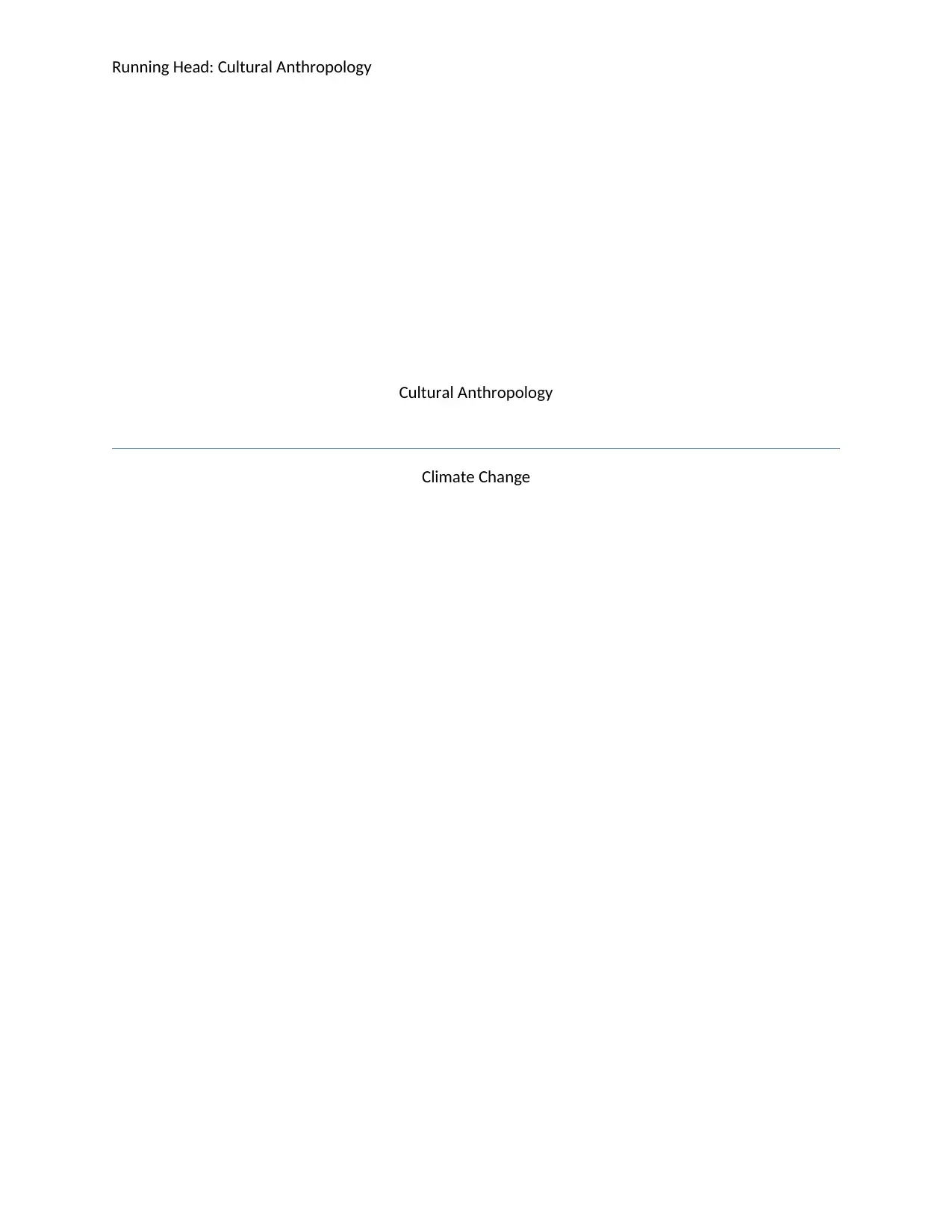
Running Head: Cultural Anthropology
Cultural Anthropology
Climate Change
Cultural Anthropology
Climate Change
Secure Best Marks with AI Grader
Need help grading? Try our AI Grader for instant feedback on your assignments.
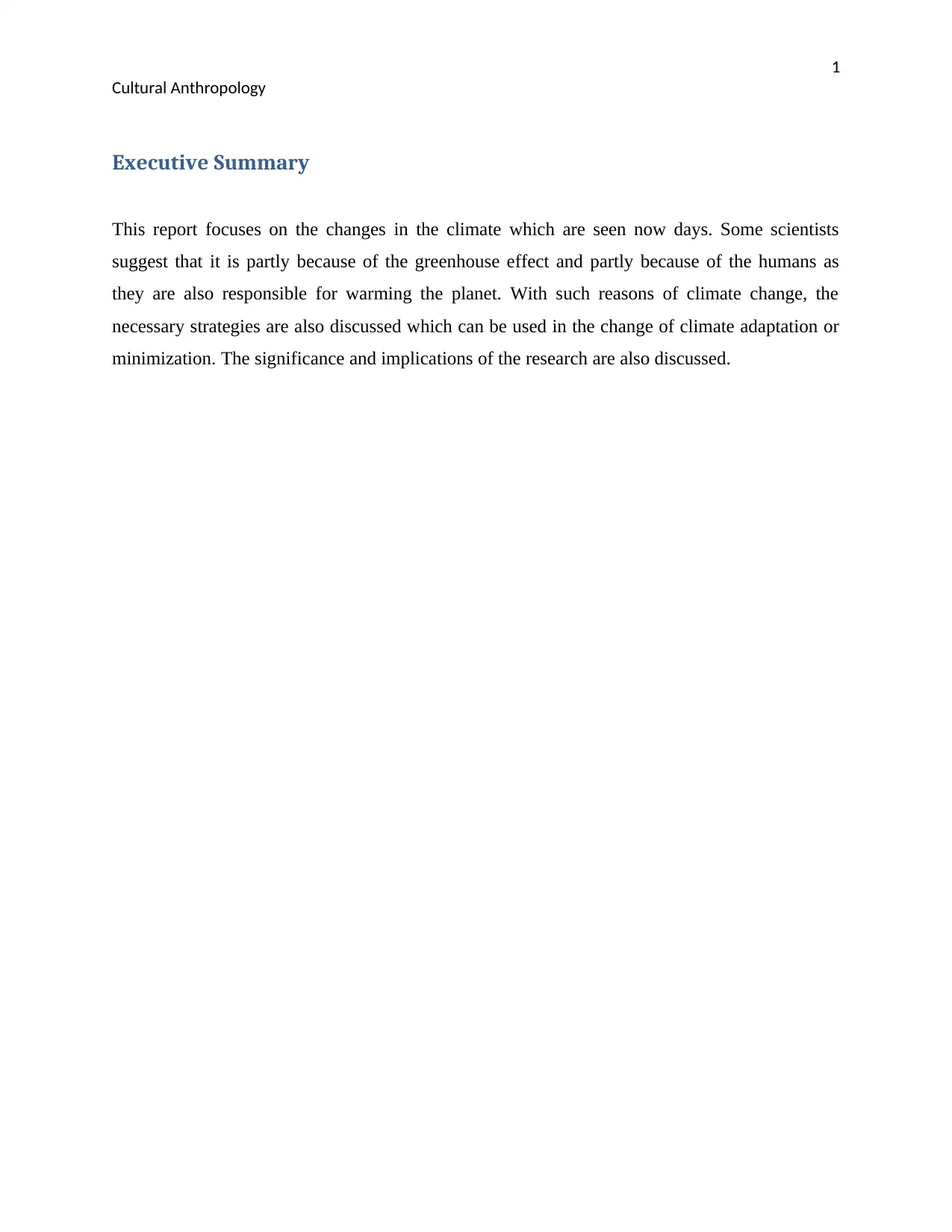
1
Cultural Anthropology
Executive Summary
This report focuses on the changes in the climate which are seen now days. Some scientists
suggest that it is partly because of the greenhouse effect and partly because of the humans as
they are also responsible for warming the planet. With such reasons of climate change, the
necessary strategies are also discussed which can be used in the change of climate adaptation or
minimization. The significance and implications of the research are also discussed.
Cultural Anthropology
Executive Summary
This report focuses on the changes in the climate which are seen now days. Some scientists
suggest that it is partly because of the greenhouse effect and partly because of the humans as
they are also responsible for warming the planet. With such reasons of climate change, the
necessary strategies are also discussed which can be used in the change of climate adaptation or
minimization. The significance and implications of the research are also discussed.
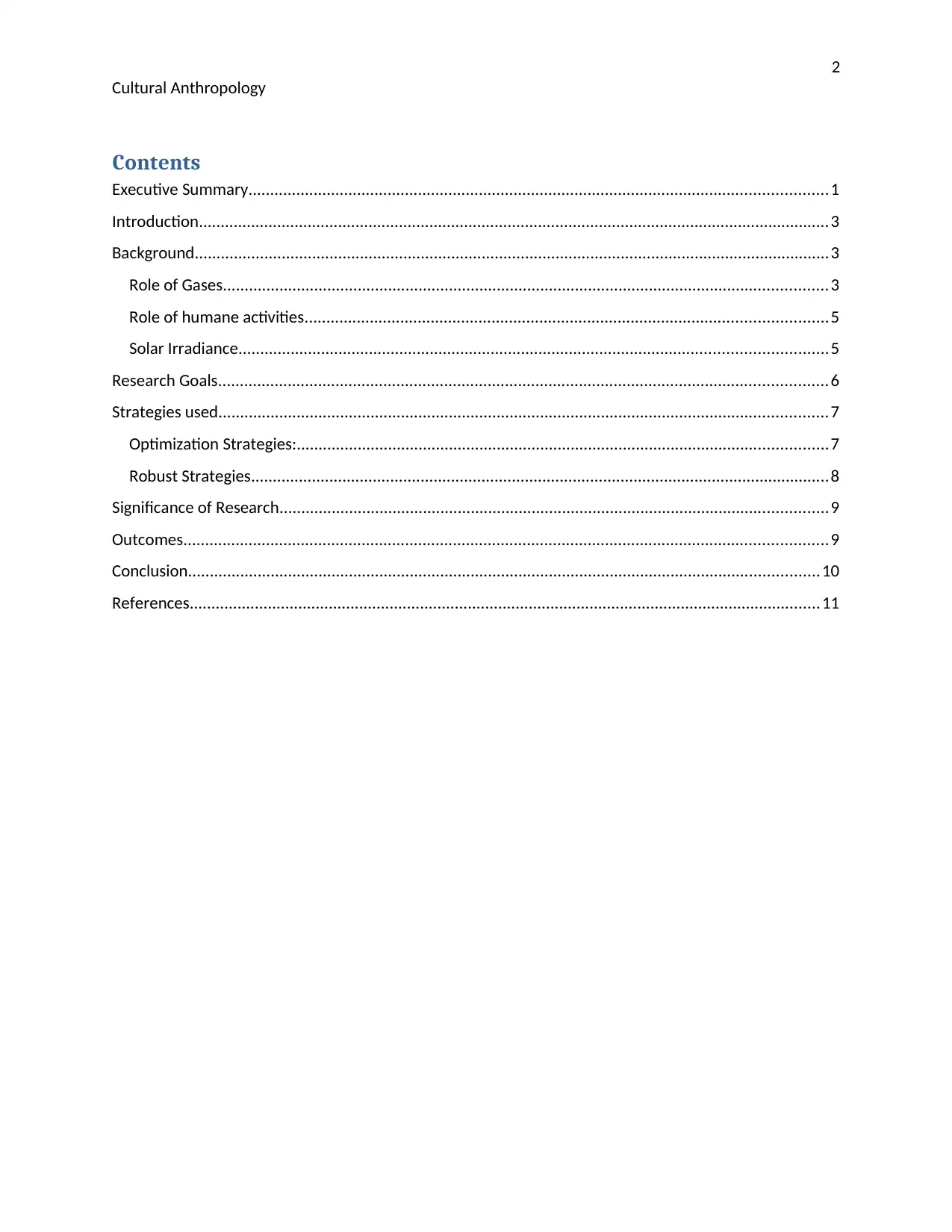
2
Cultural Anthropology
Contents
Executive Summary.....................................................................................................................................1
Introduction.................................................................................................................................................3
Background..................................................................................................................................................3
Role of Gases...........................................................................................................................................3
Role of humane activities........................................................................................................................5
Solar Irradiance.......................................................................................................................................5
Research Goals............................................................................................................................................6
Strategies used............................................................................................................................................7
Optimization Strategies:..........................................................................................................................7
Robust Strategies.....................................................................................................................................8
Significance of Research..............................................................................................................................9
Outcomes....................................................................................................................................................9
Conclusion.................................................................................................................................................10
References.................................................................................................................................................11
Cultural Anthropology
Contents
Executive Summary.....................................................................................................................................1
Introduction.................................................................................................................................................3
Background..................................................................................................................................................3
Role of Gases...........................................................................................................................................3
Role of humane activities........................................................................................................................5
Solar Irradiance.......................................................................................................................................5
Research Goals............................................................................................................................................6
Strategies used............................................................................................................................................7
Optimization Strategies:..........................................................................................................................7
Robust Strategies.....................................................................................................................................8
Significance of Research..............................................................................................................................9
Outcomes....................................................................................................................................................9
Conclusion.................................................................................................................................................10
References.................................................................................................................................................11
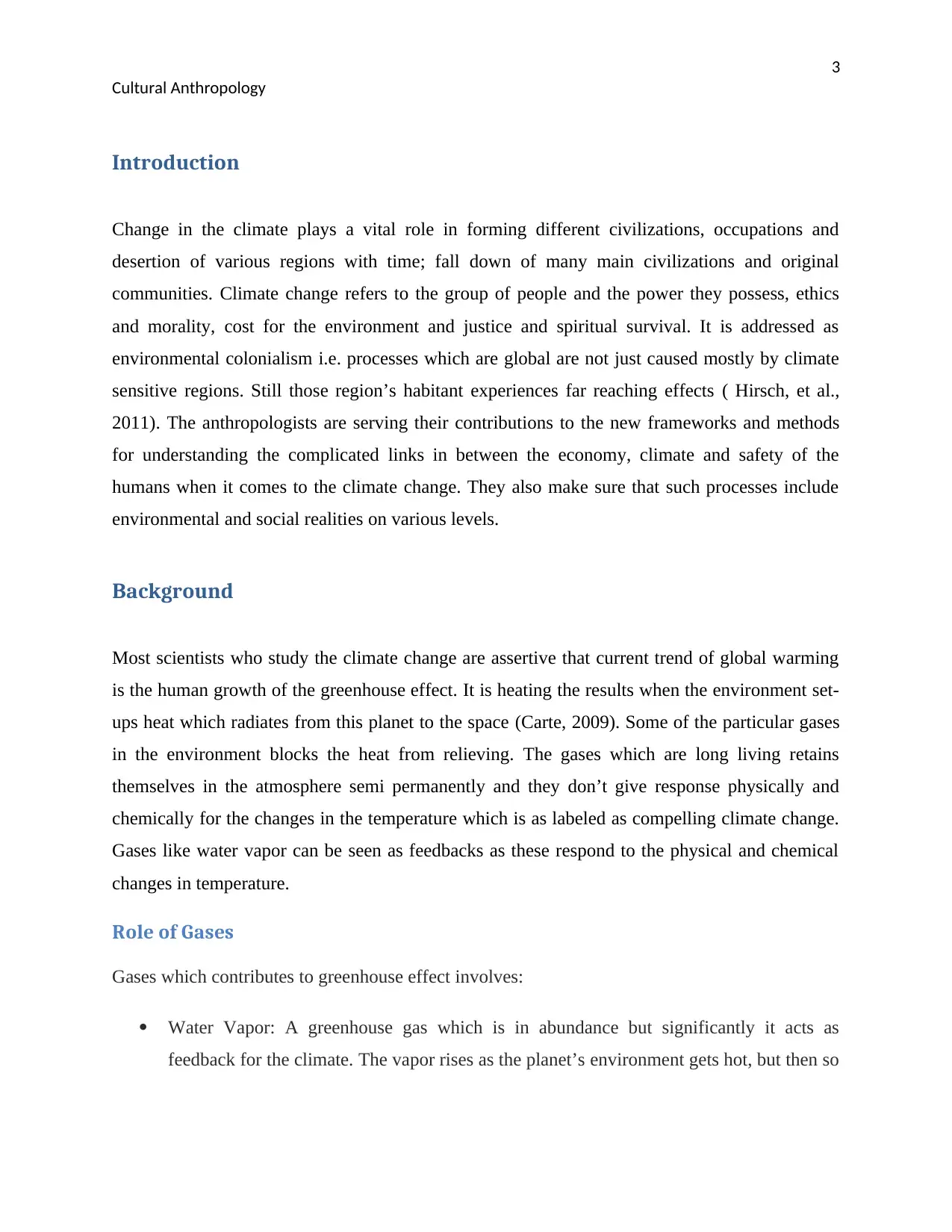
3
Cultural Anthropology
Introduction
Change in the climate plays a vital role in forming different civilizations, occupations and
desertion of various regions with time; fall down of many main civilizations and original
communities. Climate change refers to the group of people and the power they possess, ethics
and morality, cost for the environment and justice and spiritual survival. It is addressed as
environmental colonialism i.e. processes which are global are not just caused mostly by climate
sensitive regions. Still those region’s habitant experiences far reaching effects ( Hirsch, et al.,
2011). The anthropologists are serving their contributions to the new frameworks and methods
for understanding the complicated links in between the economy, climate and safety of the
humans when it comes to the climate change. They also make sure that such processes include
environmental and social realities on various levels.
Background
Most scientists who study the climate change are assertive that current trend of global warming
is the human growth of the greenhouse effect. It is heating the results when the environment set-
ups heat which radiates from this planet to the space (Carte, 2009). Some of the particular gases
in the environment blocks the heat from relieving. The gases which are long living retains
themselves in the atmosphere semi permanently and they don’t give response physically and
chemically for the changes in the temperature which is as labeled as compelling climate change.
Gases like water vapor can be seen as feedbacks as these respond to the physical and chemical
changes in temperature.
Role of Gases
Gases which contributes to greenhouse effect involves:
Water Vapor: A greenhouse gas which is in abundance but significantly it acts as
feedback for the climate. The vapor rises as the planet’s environment gets hot, but then so
Cultural Anthropology
Introduction
Change in the climate plays a vital role in forming different civilizations, occupations and
desertion of various regions with time; fall down of many main civilizations and original
communities. Climate change refers to the group of people and the power they possess, ethics
and morality, cost for the environment and justice and spiritual survival. It is addressed as
environmental colonialism i.e. processes which are global are not just caused mostly by climate
sensitive regions. Still those region’s habitant experiences far reaching effects ( Hirsch, et al.,
2011). The anthropologists are serving their contributions to the new frameworks and methods
for understanding the complicated links in between the economy, climate and safety of the
humans when it comes to the climate change. They also make sure that such processes include
environmental and social realities on various levels.
Background
Most scientists who study the climate change are assertive that current trend of global warming
is the human growth of the greenhouse effect. It is heating the results when the environment set-
ups heat which radiates from this planet to the space (Carte, 2009). Some of the particular gases
in the environment blocks the heat from relieving. The gases which are long living retains
themselves in the atmosphere semi permanently and they don’t give response physically and
chemically for the changes in the temperature which is as labeled as compelling climate change.
Gases like water vapor can be seen as feedbacks as these respond to the physical and chemical
changes in temperature.
Role of Gases
Gases which contributes to greenhouse effect involves:
Water Vapor: A greenhouse gas which is in abundance but significantly it acts as
feedback for the climate. The vapor rises as the planet’s environment gets hot, but then so
Secure Best Marks with AI Grader
Need help grading? Try our AI Grader for instant feedback on your assignments.
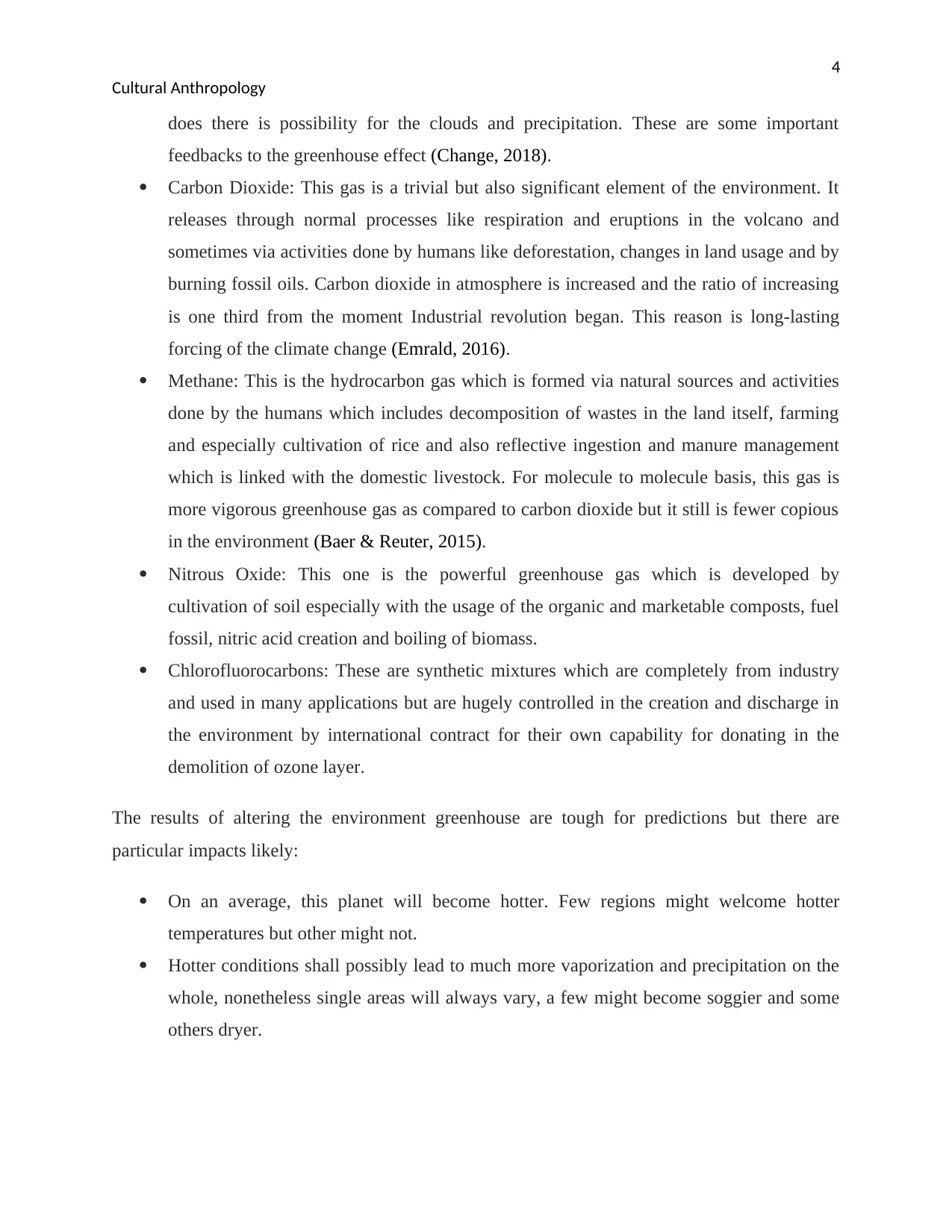
4
Cultural Anthropology
does there is possibility for the clouds and precipitation. These are some important
feedbacks to the greenhouse effect (Change, 2018).
Carbon Dioxide: This gas is a trivial but also significant element of the environment. It
releases through normal processes like respiration and eruptions in the volcano and
sometimes via activities done by humans like deforestation, changes in land usage and by
burning fossil oils. Carbon dioxide in atmosphere is increased and the ratio of increasing
is one third from the moment Industrial revolution began. This reason is long-lasting
forcing of the climate change (Emrald, 2016).
Methane: This is the hydrocarbon gas which is formed via natural sources and activities
done by the humans which includes decomposition of wastes in the land itself, farming
and especially cultivation of rice and also reflective ingestion and manure management
which is linked with the domestic livestock. For molecule to molecule basis, this gas is
more vigorous greenhouse gas as compared to carbon dioxide but it still is fewer copious
in the environment (Baer & Reuter, 2015).
Nitrous Oxide: This one is the powerful greenhouse gas which is developed by
cultivation of soil especially with the usage of the organic and marketable composts, fuel
fossil, nitric acid creation and boiling of biomass.
Chlorofluorocarbons: These are synthetic mixtures which are completely from industry
and used in many applications but are hugely controlled in the creation and discharge in
the environment by international contract for their own capability for donating in the
demolition of ozone layer.
The results of altering the environment greenhouse are tough for predictions but there are
particular impacts likely:
On an average, this planet will become hotter. Few regions might welcome hotter
temperatures but other might not.
Hotter conditions shall possibly lead to much more vaporization and precipitation on the
whole, nonetheless single areas will always vary, a few might become soggier and some
others dryer.
Cultural Anthropology
does there is possibility for the clouds and precipitation. These are some important
feedbacks to the greenhouse effect (Change, 2018).
Carbon Dioxide: This gas is a trivial but also significant element of the environment. It
releases through normal processes like respiration and eruptions in the volcano and
sometimes via activities done by humans like deforestation, changes in land usage and by
burning fossil oils. Carbon dioxide in atmosphere is increased and the ratio of increasing
is one third from the moment Industrial revolution began. This reason is long-lasting
forcing of the climate change (Emrald, 2016).
Methane: This is the hydrocarbon gas which is formed via natural sources and activities
done by the humans which includes decomposition of wastes in the land itself, farming
and especially cultivation of rice and also reflective ingestion and manure management
which is linked with the domestic livestock. For molecule to molecule basis, this gas is
more vigorous greenhouse gas as compared to carbon dioxide but it still is fewer copious
in the environment (Baer & Reuter, 2015).
Nitrous Oxide: This one is the powerful greenhouse gas which is developed by
cultivation of soil especially with the usage of the organic and marketable composts, fuel
fossil, nitric acid creation and boiling of biomass.
Chlorofluorocarbons: These are synthetic mixtures which are completely from industry
and used in many applications but are hugely controlled in the creation and discharge in
the environment by international contract for their own capability for donating in the
demolition of ozone layer.
The results of altering the environment greenhouse are tough for predictions but there are
particular impacts likely:
On an average, this planet will become hotter. Few regions might welcome hotter
temperatures but other might not.
Hotter conditions shall possibly lead to much more vaporization and precipitation on the
whole, nonetheless single areas will always vary, a few might become soggier and some
others dryer.

5
Cultural Anthropology
If greenhouse impact warms oceans and to specific extent melt the glaciers, the seal level
rises. Water of the ocean might also increase if the effect reheats which can contribute
further to sea level rise.
In the meanwhile, few crops and other plants might response positively to rise up the
carbon di oxide which is in the atmosphere, developing more robustly and the water
usage proficiently. On the similar time, the upper temperature and flowing climate shapes
might alter the locations where yields develop the finest and impact the face of
communities of natural plant.
Role of humane activities
In a report of Intergovernmental Panel on Climate Change, 1300 scientists from all over the
world in UN concluded that there it is 90% sure that human activities have warmed the planet
since last 50 years.
The activities related to industry on which the contemporary evolution is dependent upon has
raised the carbon dioxide from 280 to 400 million parts in the last 1500 years. The panel also
ended by saying that it is also a possibility that because of humans, 95% of the gases like Co2,
methane and nitrous oxide are created for 50 years (Haunschild, et al., 2016).
Solar Irradiance
It will not be wrong to accept that climate changes in the energy of the sun output would cause
the climate to change, since the sun is the major source of the energy which drives the climate
system.
Obviously, the studies have shown that the solar variability plays a vital role in past changes in
the climate. For Example: a down fall in the solar movement is thought to have prompted the
little ice age in between 1650 and 1850, when Greenland was hugely cut off by Ice from 1410 till
the 1720s (Unfccc, 2006).
A few proofs show that present global warming cannot be explained by the conversions in the
energy from the sun:
Cultural Anthropology
If greenhouse impact warms oceans and to specific extent melt the glaciers, the seal level
rises. Water of the ocean might also increase if the effect reheats which can contribute
further to sea level rise.
In the meanwhile, few crops and other plants might response positively to rise up the
carbon di oxide which is in the atmosphere, developing more robustly and the water
usage proficiently. On the similar time, the upper temperature and flowing climate shapes
might alter the locations where yields develop the finest and impact the face of
communities of natural plant.
Role of humane activities
In a report of Intergovernmental Panel on Climate Change, 1300 scientists from all over the
world in UN concluded that there it is 90% sure that human activities have warmed the planet
since last 50 years.
The activities related to industry on which the contemporary evolution is dependent upon has
raised the carbon dioxide from 280 to 400 million parts in the last 1500 years. The panel also
ended by saying that it is also a possibility that because of humans, 95% of the gases like Co2,
methane and nitrous oxide are created for 50 years (Haunschild, et al., 2016).
Solar Irradiance
It will not be wrong to accept that climate changes in the energy of the sun output would cause
the climate to change, since the sun is the major source of the energy which drives the climate
system.
Obviously, the studies have shown that the solar variability plays a vital role in past changes in
the climate. For Example: a down fall in the solar movement is thought to have prompted the
little ice age in between 1650 and 1850, when Greenland was hugely cut off by Ice from 1410 till
the 1720s (Unfccc, 2006).
A few proofs show that present global warming cannot be explained by the conversions in the
energy from the sun:
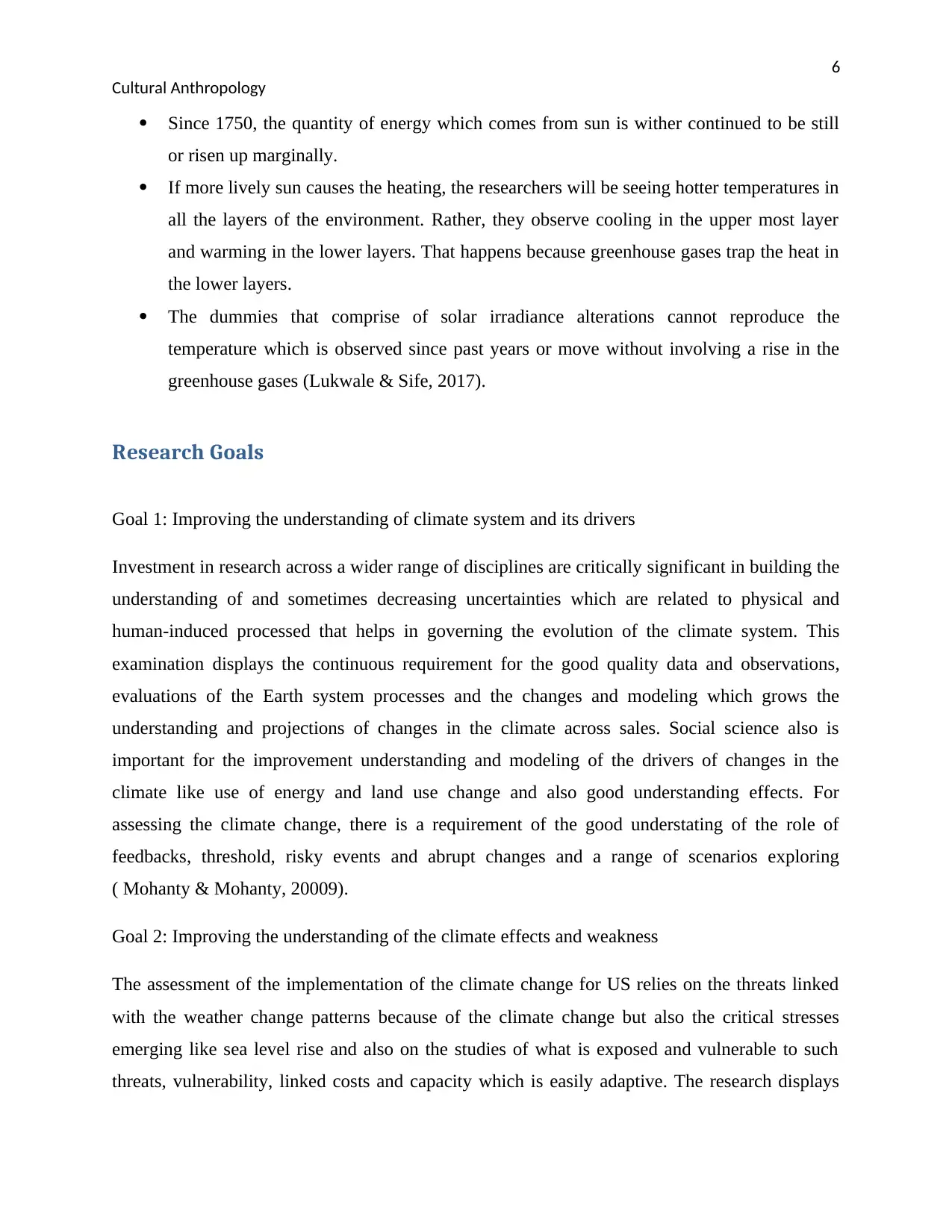
6
Cultural Anthropology
Since 1750, the quantity of energy which comes from sun is wither continued to be still
or risen up marginally.
If more lively sun causes the heating, the researchers will be seeing hotter temperatures in
all the layers of the environment. Rather, they observe cooling in the upper most layer
and warming in the lower layers. That happens because greenhouse gases trap the heat in
the lower layers.
The dummies that comprise of solar irradiance alterations cannot reproduce the
temperature which is observed since past years or move without involving a rise in the
greenhouse gases (Lukwale & Sife, 2017).
Research Goals
Goal 1: Improving the understanding of climate system and its drivers
Investment in research across a wider range of disciplines are critically significant in building the
understanding of and sometimes decreasing uncertainties which are related to physical and
human-induced processed that helps in governing the evolution of the climate system. This
examination displays the continuous requirement for the good quality data and observations,
evaluations of the Earth system processes and the changes and modeling which grows the
understanding and projections of changes in the climate across sales. Social science also is
important for the improvement understanding and modeling of the drivers of changes in the
climate like use of energy and land use change and also good understanding effects. For
assessing the climate change, there is a requirement of the good understating of the role of
feedbacks, threshold, risky events and abrupt changes and a range of scenarios exploring
( Mohanty & Mohanty, 20009).
Goal 2: Improving the understanding of the climate effects and weakness
The assessment of the implementation of the climate change for US relies on the threats linked
with the weather change patterns because of the climate change but also the critical stresses
emerging like sea level rise and also on the studies of what is exposed and vulnerable to such
threats, vulnerability, linked costs and capacity which is easily adaptive. The research displays
Cultural Anthropology
Since 1750, the quantity of energy which comes from sun is wither continued to be still
or risen up marginally.
If more lively sun causes the heating, the researchers will be seeing hotter temperatures in
all the layers of the environment. Rather, they observe cooling in the upper most layer
and warming in the lower layers. That happens because greenhouse gases trap the heat in
the lower layers.
The dummies that comprise of solar irradiance alterations cannot reproduce the
temperature which is observed since past years or move without involving a rise in the
greenhouse gases (Lukwale & Sife, 2017).
Research Goals
Goal 1: Improving the understanding of climate system and its drivers
Investment in research across a wider range of disciplines are critically significant in building the
understanding of and sometimes decreasing uncertainties which are related to physical and
human-induced processed that helps in governing the evolution of the climate system. This
examination displays the continuous requirement for the good quality data and observations,
evaluations of the Earth system processes and the changes and modeling which grows the
understanding and projections of changes in the climate across sales. Social science also is
important for the improvement understanding and modeling of the drivers of changes in the
climate like use of energy and land use change and also good understanding effects. For
assessing the climate change, there is a requirement of the good understating of the role of
feedbacks, threshold, risky events and abrupt changes and a range of scenarios exploring
( Mohanty & Mohanty, 20009).
Goal 2: Improving the understanding of the climate effects and weakness
The assessment of the implementation of the climate change for US relies on the threats linked
with the weather change patterns because of the climate change but also the critical stresses
emerging like sea level rise and also on the studies of what is exposed and vulnerable to such
threats, vulnerability, linked costs and capacity which is easily adaptive. The research displays
Paraphrase This Document
Need a fresh take? Get an instant paraphrase of this document with our AI Paraphraser

7
Cultural Anthropology
the moderate progress that is made in understanding of the extent to which normal human
systems are sensitive to climate and how such sensitive factors links with the trends of climate
change and exposures to develop effects but still there is need for building the capacity for the
vulnerability assessment.
Goal 3: Increase in the understanding of adaptation trails
This assessment, counting the Climate Choices Adapting to the Influences of Climate
Change report and of the Intergovernmental Panel on Climate Change’s (IPCC) AR4 Synthesis
Report, classifies a wide-ranging set of research requirements for the understanding and
implementing of adaptation. These comprise of investigation on adaptation procedures, adaptive
capacity, adaptation option identification, implementation and valuation, and adaptive
management of hazards and chances. Significant requirements involve research on the, timing of,
and tradeoffs in adaptation, and considering as to how adaptation interrelates with modification
activities, stresses, and wider sustainability matters (Nca, 2014).
Goal 4: Recognize the modification choices that decrease the possibility of long-term climate
changes
The strictness of climate change influences the necessity for adapting to them for longer period
depends on the accomplishment of labors to decrease the heat-trapping greenhouse gas (GHG)
releases, especially those linked with burning of fossil fuels but also those related with changes
in the use of the land (Rosenberg, et al., 2010).
Goal 5: Improving the judgement support and combined assessment
For assessments to be beneficial to the policy makers, they require to deliver combined
consequences that can be used in decision-making. Research can grow tools that enable the
decision-making and the addition of information.
Strategies used
Optimization Strategies:
Cost benefit Strategy: CBA is a technique which pursues to deliver the utmost profit of
result, with respect to the related costs of a certain option of adaptation. This benefit is
Cultural Anthropology
the moderate progress that is made in understanding of the extent to which normal human
systems are sensitive to climate and how such sensitive factors links with the trends of climate
change and exposures to develop effects but still there is need for building the capacity for the
vulnerability assessment.
Goal 3: Increase in the understanding of adaptation trails
This assessment, counting the Climate Choices Adapting to the Influences of Climate
Change report and of the Intergovernmental Panel on Climate Change’s (IPCC) AR4 Synthesis
Report, classifies a wide-ranging set of research requirements for the understanding and
implementing of adaptation. These comprise of investigation on adaptation procedures, adaptive
capacity, adaptation option identification, implementation and valuation, and adaptive
management of hazards and chances. Significant requirements involve research on the, timing of,
and tradeoffs in adaptation, and considering as to how adaptation interrelates with modification
activities, stresses, and wider sustainability matters (Nca, 2014).
Goal 4: Recognize the modification choices that decrease the possibility of long-term climate
changes
The strictness of climate change influences the necessity for adapting to them for longer period
depends on the accomplishment of labors to decrease the heat-trapping greenhouse gas (GHG)
releases, especially those linked with burning of fossil fuels but also those related with changes
in the use of the land (Rosenberg, et al., 2010).
Goal 5: Improving the judgement support and combined assessment
For assessments to be beneficial to the policy makers, they require to deliver combined
consequences that can be used in decision-making. Research can grow tools that enable the
decision-making and the addition of information.
Strategies used
Optimization Strategies:
Cost benefit Strategy: CBA is a technique which pursues to deliver the utmost profit of
result, with respect to the related costs of a certain option of adaptation. This benefit is
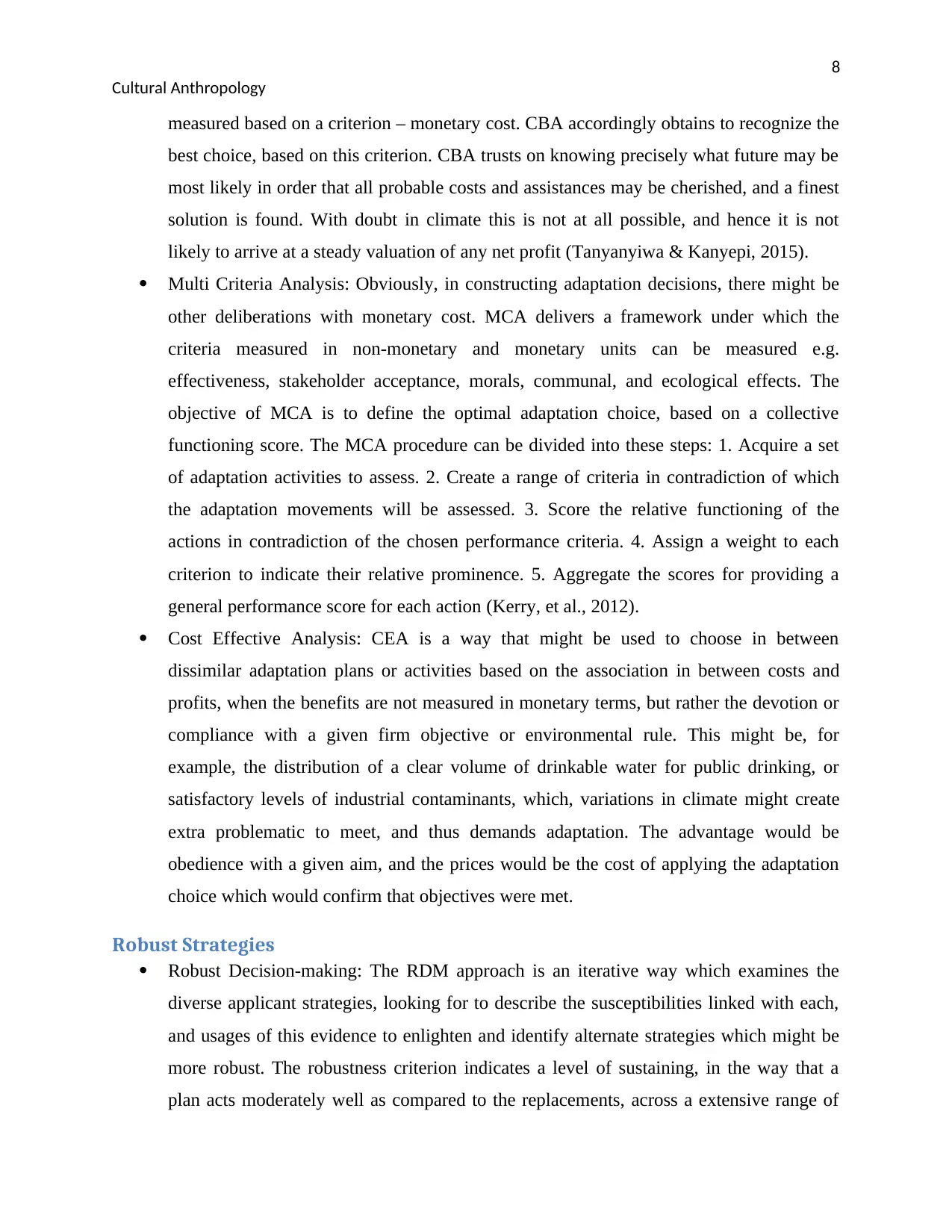
8
Cultural Anthropology
measured based on a criterion – monetary cost. CBA accordingly obtains to recognize the
best choice, based on this criterion. CBA trusts on knowing precisely what future may be
most likely in order that all probable costs and assistances may be cherished, and a finest
solution is found. With doubt in climate this is not at all possible, and hence it is not
likely to arrive at a steady valuation of any net profit (Tanyanyiwa & Kanyepi, 2015).
Multi Criteria Analysis: Obviously, in constructing adaptation decisions, there might be
other deliberations with monetary cost. MCA delivers a framework under which the
criteria measured in non-monetary and monetary units can be measured e.g.
effectiveness, stakeholder acceptance, morals, communal, and ecological effects. The
objective of MCA is to define the optimal adaptation choice, based on a collective
functioning score. The MCA procedure can be divided into these steps: 1. Acquire a set
of adaptation activities to assess. 2. Create a range of criteria in contradiction of which
the adaptation movements will be assessed. 3. Score the relative functioning of the
actions in contradiction of the chosen performance criteria. 4. Assign a weight to each
criterion to indicate their relative prominence. 5. Aggregate the scores for providing a
general performance score for each action (Kerry, et al., 2012).
Cost Effective Analysis: CEA is a way that might be used to choose in between
dissimilar adaptation plans or activities based on the association in between costs and
profits, when the benefits are not measured in monetary terms, but rather the devotion or
compliance with a given firm objective or environmental rule. This might be, for
example, the distribution of a clear volume of drinkable water for public drinking, or
satisfactory levels of industrial contaminants, which, variations in climate might create
extra problematic to meet, and thus demands adaptation. The advantage would be
obedience with a given aim, and the prices would be the cost of applying the adaptation
choice which would confirm that objectives were met.
Robust Strategies
Robust Decision-making: The RDM approach is an iterative way which examines the
diverse applicant strategies, looking for to describe the susceptibilities linked with each,
and usages of this evidence to enlighten and identify alternate strategies which might be
more robust. The robustness criterion indicates a level of sustaining, in the way that a
plan acts moderately well as compared to the replacements, across a extensive range of
Cultural Anthropology
measured based on a criterion – monetary cost. CBA accordingly obtains to recognize the
best choice, based on this criterion. CBA trusts on knowing precisely what future may be
most likely in order that all probable costs and assistances may be cherished, and a finest
solution is found. With doubt in climate this is not at all possible, and hence it is not
likely to arrive at a steady valuation of any net profit (Tanyanyiwa & Kanyepi, 2015).
Multi Criteria Analysis: Obviously, in constructing adaptation decisions, there might be
other deliberations with monetary cost. MCA delivers a framework under which the
criteria measured in non-monetary and monetary units can be measured e.g.
effectiveness, stakeholder acceptance, morals, communal, and ecological effects. The
objective of MCA is to define the optimal adaptation choice, based on a collective
functioning score. The MCA procedure can be divided into these steps: 1. Acquire a set
of adaptation activities to assess. 2. Create a range of criteria in contradiction of which
the adaptation movements will be assessed. 3. Score the relative functioning of the
actions in contradiction of the chosen performance criteria. 4. Assign a weight to each
criterion to indicate their relative prominence. 5. Aggregate the scores for providing a
general performance score for each action (Kerry, et al., 2012).
Cost Effective Analysis: CEA is a way that might be used to choose in between
dissimilar adaptation plans or activities based on the association in between costs and
profits, when the benefits are not measured in monetary terms, but rather the devotion or
compliance with a given firm objective or environmental rule. This might be, for
example, the distribution of a clear volume of drinkable water for public drinking, or
satisfactory levels of industrial contaminants, which, variations in climate might create
extra problematic to meet, and thus demands adaptation. The advantage would be
obedience with a given aim, and the prices would be the cost of applying the adaptation
choice which would confirm that objectives were met.
Robust Strategies
Robust Decision-making: The RDM approach is an iterative way which examines the
diverse applicant strategies, looking for to describe the susceptibilities linked with each,
and usages of this evidence to enlighten and identify alternate strategies which might be
more robust. The robustness criterion indicates a level of sustaining, in the way that a
plan acts moderately well as compared to the replacements, across a extensive range of
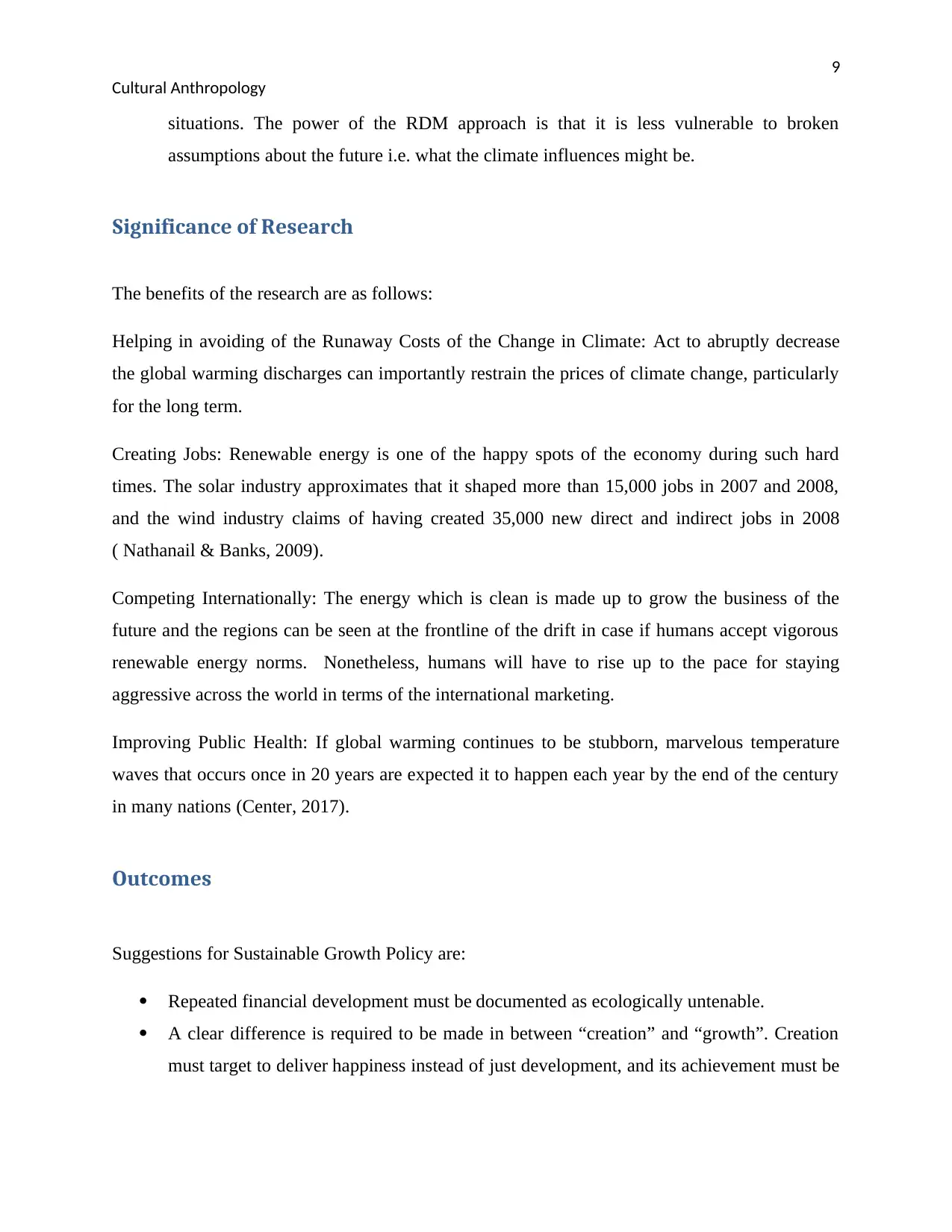
9
Cultural Anthropology
situations. The power of the RDM approach is that it is less vulnerable to broken
assumptions about the future i.e. what the climate influences might be.
Significance of Research
The benefits of the research are as follows:
Helping in avoiding of the Runaway Costs of the Change in Climate: Act to abruptly decrease
the global warming discharges can importantly restrain the prices of climate change, particularly
for the long term.
Creating Jobs: Renewable energy is one of the happy spots of the economy during such hard
times. The solar industry approximates that it shaped more than 15,000 jobs in 2007 and 2008,
and the wind industry claims of having created 35,000 new direct and indirect jobs in 2008
( Nathanail & Banks, 2009).
Competing Internationally: The energy which is clean is made up to grow the business of the
future and the regions can be seen at the frontline of the drift in case if humans accept vigorous
renewable energy norms. Nonetheless, humans will have to rise up to the pace for staying
aggressive across the world in terms of the international marketing.
Improving Public Health: If global warming continues to be stubborn, marvelous temperature
waves that occurs once in 20 years are expected it to happen each year by the end of the century
in many nations (Center, 2017).
Outcomes
Suggestions for Sustainable Growth Policy are:
Repeated financial development must be documented as ecologically untenable.
A clear difference is required to be made in between “creation” and “growth”. Creation
must target to deliver happiness instead of just development, and its achievement must be
Cultural Anthropology
situations. The power of the RDM approach is that it is less vulnerable to broken
assumptions about the future i.e. what the climate influences might be.
Significance of Research
The benefits of the research are as follows:
Helping in avoiding of the Runaway Costs of the Change in Climate: Act to abruptly decrease
the global warming discharges can importantly restrain the prices of climate change, particularly
for the long term.
Creating Jobs: Renewable energy is one of the happy spots of the economy during such hard
times. The solar industry approximates that it shaped more than 15,000 jobs in 2007 and 2008,
and the wind industry claims of having created 35,000 new direct and indirect jobs in 2008
( Nathanail & Banks, 2009).
Competing Internationally: The energy which is clean is made up to grow the business of the
future and the regions can be seen at the frontline of the drift in case if humans accept vigorous
renewable energy norms. Nonetheless, humans will have to rise up to the pace for staying
aggressive across the world in terms of the international marketing.
Improving Public Health: If global warming continues to be stubborn, marvelous temperature
waves that occurs once in 20 years are expected it to happen each year by the end of the century
in many nations (Center, 2017).
Outcomes
Suggestions for Sustainable Growth Policy are:
Repeated financial development must be documented as ecologically untenable.
A clear difference is required to be made in between “creation” and “growth”. Creation
must target to deliver happiness instead of just development, and its achievement must be
Secure Best Marks with AI Grader
Need help grading? Try our AI Grader for instant feedback on your assignments.
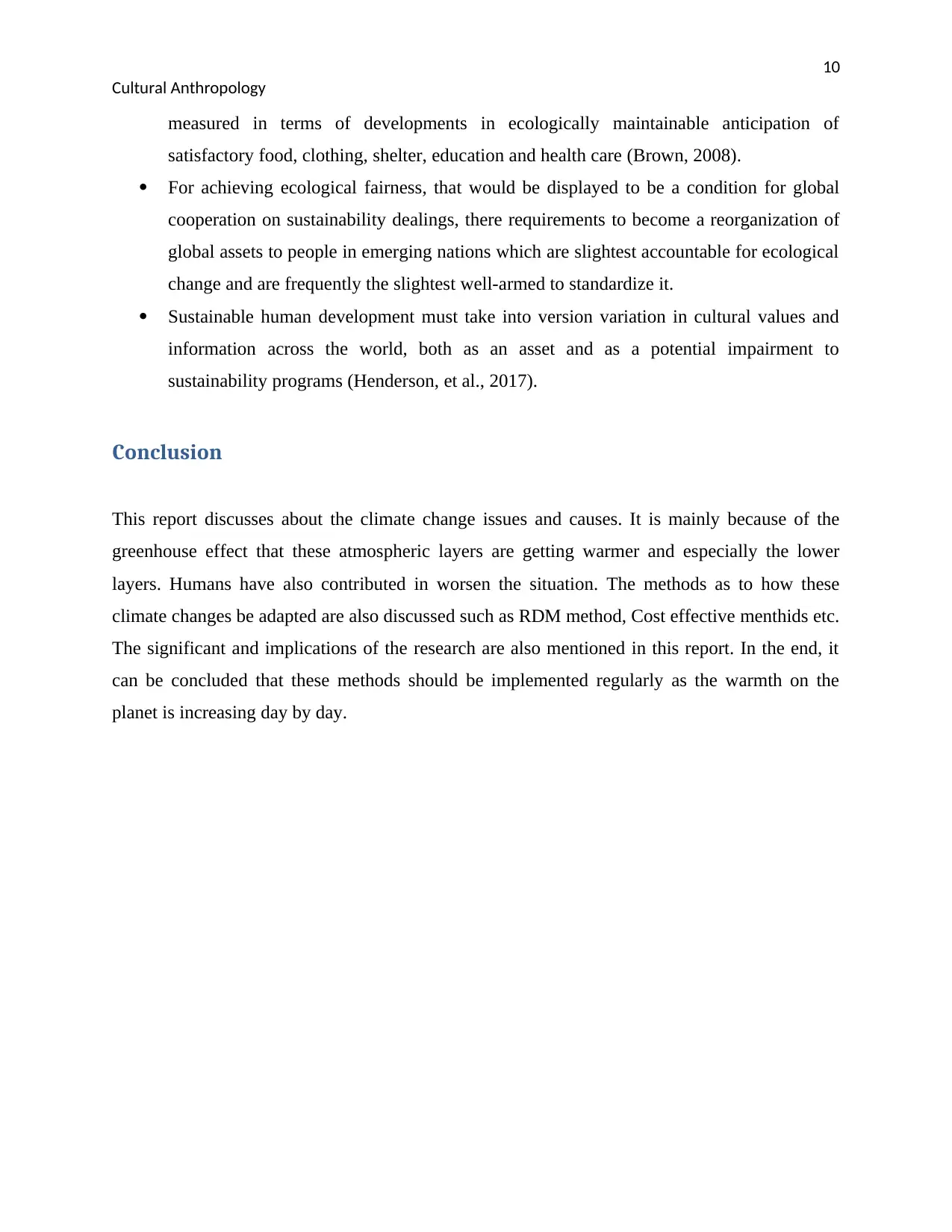
10
Cultural Anthropology
measured in terms of developments in ecologically maintainable anticipation of
satisfactory food, clothing, shelter, education and health care (Brown, 2008).
For achieving ecological fairness, that would be displayed to be a condition for global
cooperation on sustainability dealings, there requirements to become a reorganization of
global assets to people in emerging nations which are slightest accountable for ecological
change and are frequently the slightest well-armed to standardize it.
Sustainable human development must take into version variation in cultural values and
information across the world, both as an asset and as a potential impairment to
sustainability programs (Henderson, et al., 2017).
Conclusion
This report discusses about the climate change issues and causes. It is mainly because of the
greenhouse effect that these atmospheric layers are getting warmer and especially the lower
layers. Humans have also contributed in worsen the situation. The methods as to how these
climate changes be adapted are also discussed such as RDM method, Cost effective menthids etc.
The significant and implications of the research are also mentioned in this report. In the end, it
can be concluded that these methods should be implemented regularly as the warmth on the
planet is increasing day by day.
Cultural Anthropology
measured in terms of developments in ecologically maintainable anticipation of
satisfactory food, clothing, shelter, education and health care (Brown, 2008).
For achieving ecological fairness, that would be displayed to be a condition for global
cooperation on sustainability dealings, there requirements to become a reorganization of
global assets to people in emerging nations which are slightest accountable for ecological
change and are frequently the slightest well-armed to standardize it.
Sustainable human development must take into version variation in cultural values and
information across the world, both as an asset and as a potential impairment to
sustainability programs (Henderson, et al., 2017).
Conclusion
This report discusses about the climate change issues and causes. It is mainly because of the
greenhouse effect that these atmospheric layers are getting warmer and especially the lower
layers. Humans have also contributed in worsen the situation. The methods as to how these
climate changes be adapted are also discussed such as RDM method, Cost effective menthids etc.
The significant and implications of the research are also mentioned in this report. In the end, it
can be concluded that these methods should be implemented regularly as the warmth on the
planet is increasing day by day.
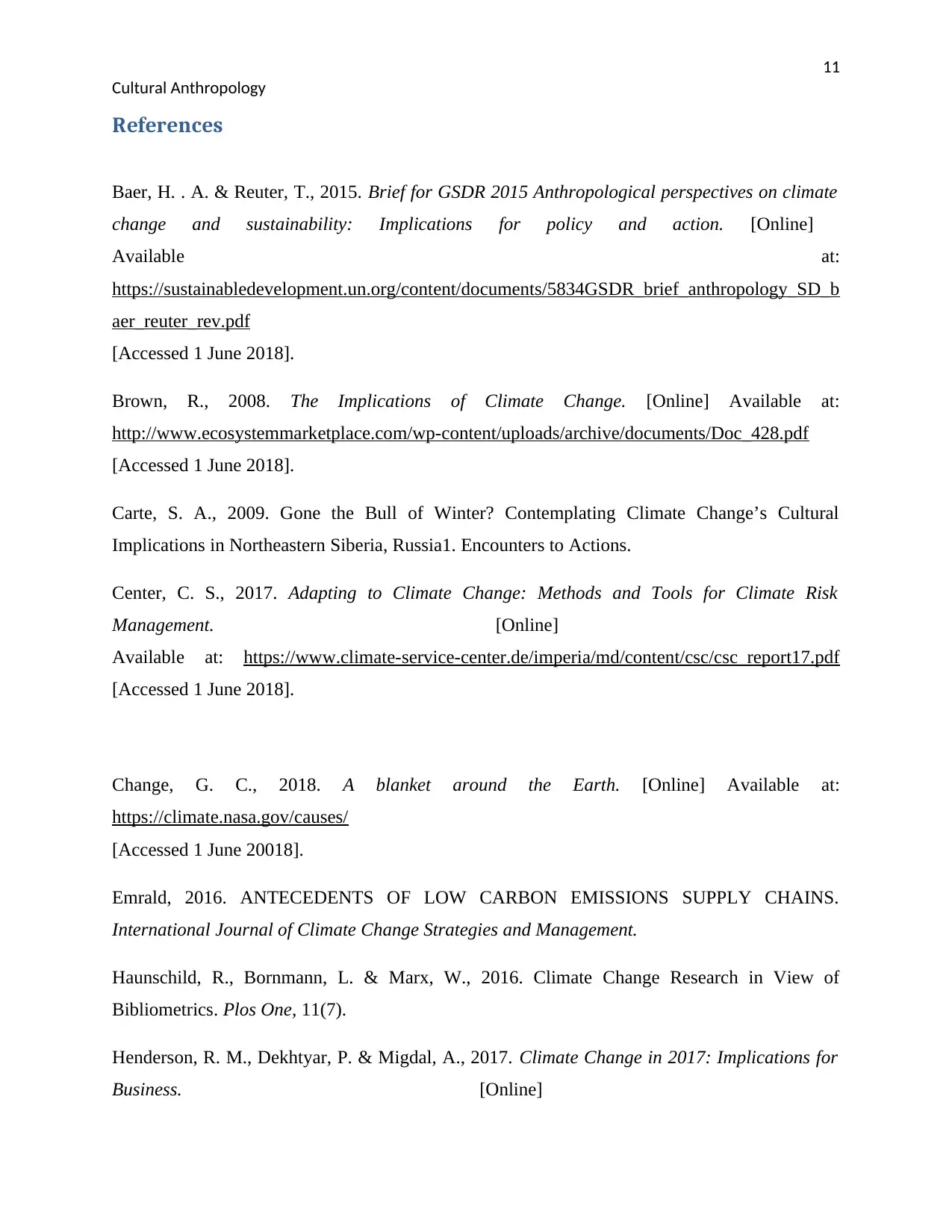
11
Cultural Anthropology
References
Baer, H. . A. & Reuter, T., 2015. Brief for GSDR 2015 Anthropological perspectives on climate
change and sustainability: Implications for policy and action. [Online]
Available at:
https://sustainabledevelopment.un.org/content/documents/5834GSDR_brief_anthropology_SD_b
aer_reuter_rev.pdf
[Accessed 1 June 2018].
Brown, R., 2008. The Implications of Climate Change. [Online] Available at:
http://www.ecosystemmarketplace.com/wp-content/uploads/archive/documents/Doc_428.pdf
[Accessed 1 June 2018].
Carte, S. A., 2009. Gone the Bull of Winter? Contemplating Climate Change’s Cultural
Implications in Northeastern Siberia, Russia1. Encounters to Actions.
Center, C. S., 2017. Adapting to Climate Change: Methods and Tools for Climate Risk
Management. [Online]
Available at: https://www.climate-service-center.de/imperia/md/content/csc/csc_report17.pdf
[Accessed 1 June 2018].
Change, G. C., 2018. A blanket around the Earth. [Online] Available at:
https://climate.nasa.gov/causes/
[Accessed 1 June 20018].
Emrald, 2016. ANTECEDENTS OF LOW CARBON EMISSIONS SUPPLY CHAINS.
International Journal of Climate Change Strategies and Management.
Haunschild, R., Bornmann, L. & Marx, W., 2016. Climate Change Research in View of
Bibliometrics. Plos One, 11(7).
Henderson, R. M., Dekhtyar, P. & Migdal, A., 2017. Climate Change in 2017: Implications for
Business. [Online]
Cultural Anthropology
References
Baer, H. . A. & Reuter, T., 2015. Brief for GSDR 2015 Anthropological perspectives on climate
change and sustainability: Implications for policy and action. [Online]
Available at:
https://sustainabledevelopment.un.org/content/documents/5834GSDR_brief_anthropology_SD_b
aer_reuter_rev.pdf
[Accessed 1 June 2018].
Brown, R., 2008. The Implications of Climate Change. [Online] Available at:
http://www.ecosystemmarketplace.com/wp-content/uploads/archive/documents/Doc_428.pdf
[Accessed 1 June 2018].
Carte, S. A., 2009. Gone the Bull of Winter? Contemplating Climate Change’s Cultural
Implications in Northeastern Siberia, Russia1. Encounters to Actions.
Center, C. S., 2017. Adapting to Climate Change: Methods and Tools for Climate Risk
Management. [Online]
Available at: https://www.climate-service-center.de/imperia/md/content/csc/csc_report17.pdf
[Accessed 1 June 2018].
Change, G. C., 2018. A blanket around the Earth. [Online] Available at:
https://climate.nasa.gov/causes/
[Accessed 1 June 20018].
Emrald, 2016. ANTECEDENTS OF LOW CARBON EMISSIONS SUPPLY CHAINS.
International Journal of Climate Change Strategies and Management.
Haunschild, R., Bornmann, L. & Marx, W., 2016. Climate Change Research in View of
Bibliometrics. Plos One, 11(7).
Henderson, R. M., Dekhtyar, P. & Migdal, A., 2017. Climate Change in 2017: Implications for
Business. [Online]
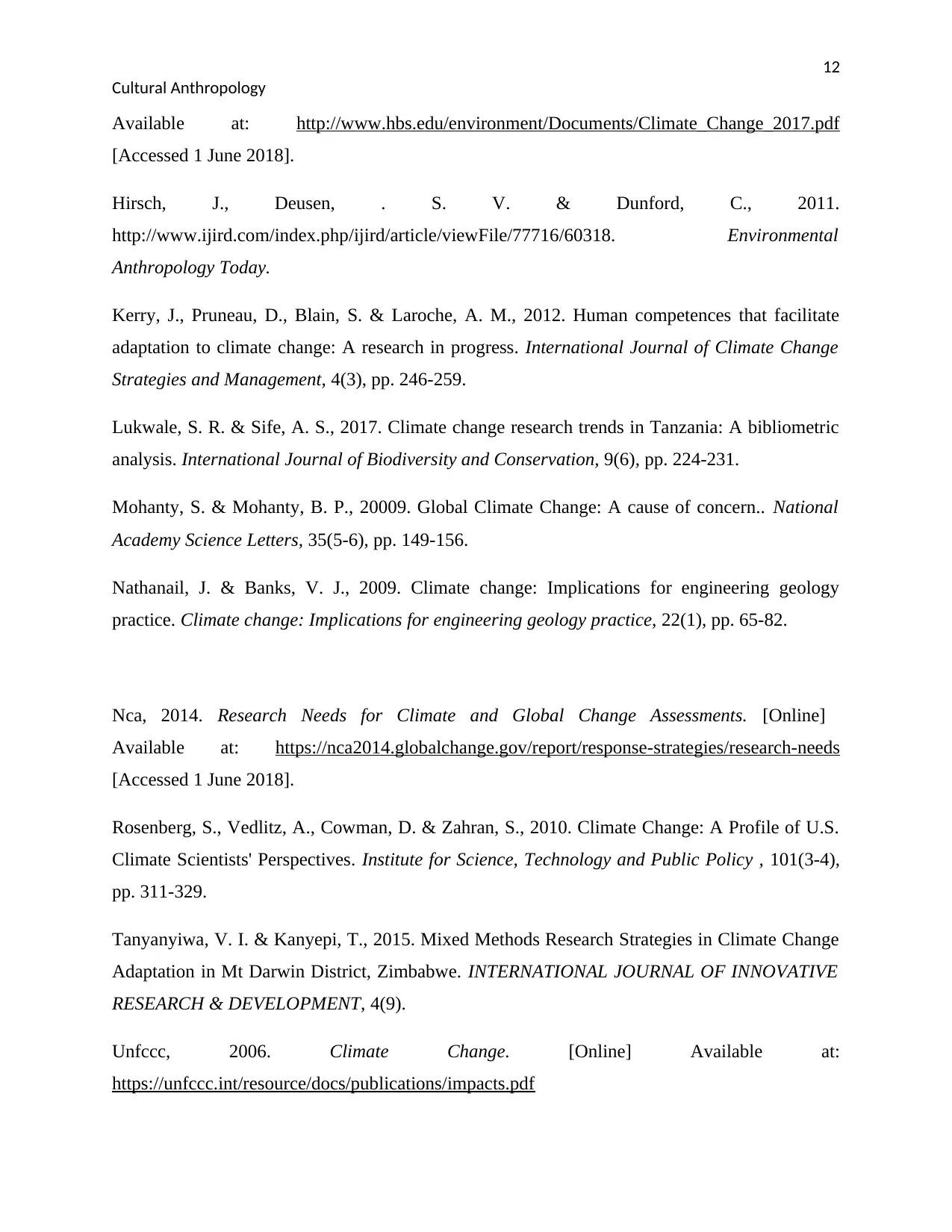
12
Cultural Anthropology
Available at: http://www.hbs.edu/environment/Documents/Climate_Change_2017.pdf
[Accessed 1 June 2018].
Hirsch, J., Deusen, . S. V. & Dunford, C., 2011.
http://www.ijird.com/index.php/ijird/article/viewFile/77716/60318. Environmental
Anthropology Today.
Kerry, J., Pruneau, D., Blain, S. & Laroche, A. M., 2012. Human competences that facilitate
adaptation to climate change: A research in progress. International Journal of Climate Change
Strategies and Management, 4(3), pp. 246-259.
Lukwale, S. R. & Sife, A. S., 2017. Climate change research trends in Tanzania: A bibliometric
analysis. International Journal of Biodiversity and Conservation, 9(6), pp. 224-231.
Mohanty, S. & Mohanty, B. P., 20009. Global Climate Change: A cause of concern.. National
Academy Science Letters, 35(5-6), pp. 149-156.
Nathanail, J. & Banks, V. J., 2009. Climate change: Implications for engineering geology
practice. Climate change: Implications for engineering geology practice, 22(1), pp. 65-82.
Nca, 2014. Research Needs for Climate and Global Change Assessments. [Online]
Available at: https://nca2014.globalchange.gov/report/response-strategies/research-needs
[Accessed 1 June 2018].
Rosenberg, S., Vedlitz, A., Cowman, D. & Zahran, S., 2010. Climate Change: A Profile of U.S.
Climate Scientists' Perspectives. Institute for Science, Technology and Public Policy , 101(3-4),
pp. 311-329.
Tanyanyiwa, V. I. & Kanyepi, T., 2015. Mixed Methods Research Strategies in Climate Change
Adaptation in Mt Darwin District, Zimbabwe. INTERNATIONAL JOURNAL OF INNOVATIVE
RESEARCH & DEVELOPMENT, 4(9).
Unfccc, 2006. Climate Change. [Online] Available at:
https://unfccc.int/resource/docs/publications/impacts.pdf
Cultural Anthropology
Available at: http://www.hbs.edu/environment/Documents/Climate_Change_2017.pdf
[Accessed 1 June 2018].
Hirsch, J., Deusen, . S. V. & Dunford, C., 2011.
http://www.ijird.com/index.php/ijird/article/viewFile/77716/60318. Environmental
Anthropology Today.
Kerry, J., Pruneau, D., Blain, S. & Laroche, A. M., 2012. Human competences that facilitate
adaptation to climate change: A research in progress. International Journal of Climate Change
Strategies and Management, 4(3), pp. 246-259.
Lukwale, S. R. & Sife, A. S., 2017. Climate change research trends in Tanzania: A bibliometric
analysis. International Journal of Biodiversity and Conservation, 9(6), pp. 224-231.
Mohanty, S. & Mohanty, B. P., 20009. Global Climate Change: A cause of concern.. National
Academy Science Letters, 35(5-6), pp. 149-156.
Nathanail, J. & Banks, V. J., 2009. Climate change: Implications for engineering geology
practice. Climate change: Implications for engineering geology practice, 22(1), pp. 65-82.
Nca, 2014. Research Needs for Climate and Global Change Assessments. [Online]
Available at: https://nca2014.globalchange.gov/report/response-strategies/research-needs
[Accessed 1 June 2018].
Rosenberg, S., Vedlitz, A., Cowman, D. & Zahran, S., 2010. Climate Change: A Profile of U.S.
Climate Scientists' Perspectives. Institute for Science, Technology and Public Policy , 101(3-4),
pp. 311-329.
Tanyanyiwa, V. I. & Kanyepi, T., 2015. Mixed Methods Research Strategies in Climate Change
Adaptation in Mt Darwin District, Zimbabwe. INTERNATIONAL JOURNAL OF INNOVATIVE
RESEARCH & DEVELOPMENT, 4(9).
Unfccc, 2006. Climate Change. [Online] Available at:
https://unfccc.int/resource/docs/publications/impacts.pdf
Paraphrase This Document
Need a fresh take? Get an instant paraphrase of this document with our AI Paraphraser

13
Cultural Anthropology
[Accessed 1 June 2018].
Cultural Anthropology
[Accessed 1 June 2018].
1 out of 14
Related Documents
Your All-in-One AI-Powered Toolkit for Academic Success.
+13062052269
info@desklib.com
Available 24*7 on WhatsApp / Email
![[object Object]](/_next/static/media/star-bottom.7253800d.svg)
Unlock your academic potential
© 2024 | Zucol Services PVT LTD | All rights reserved.





